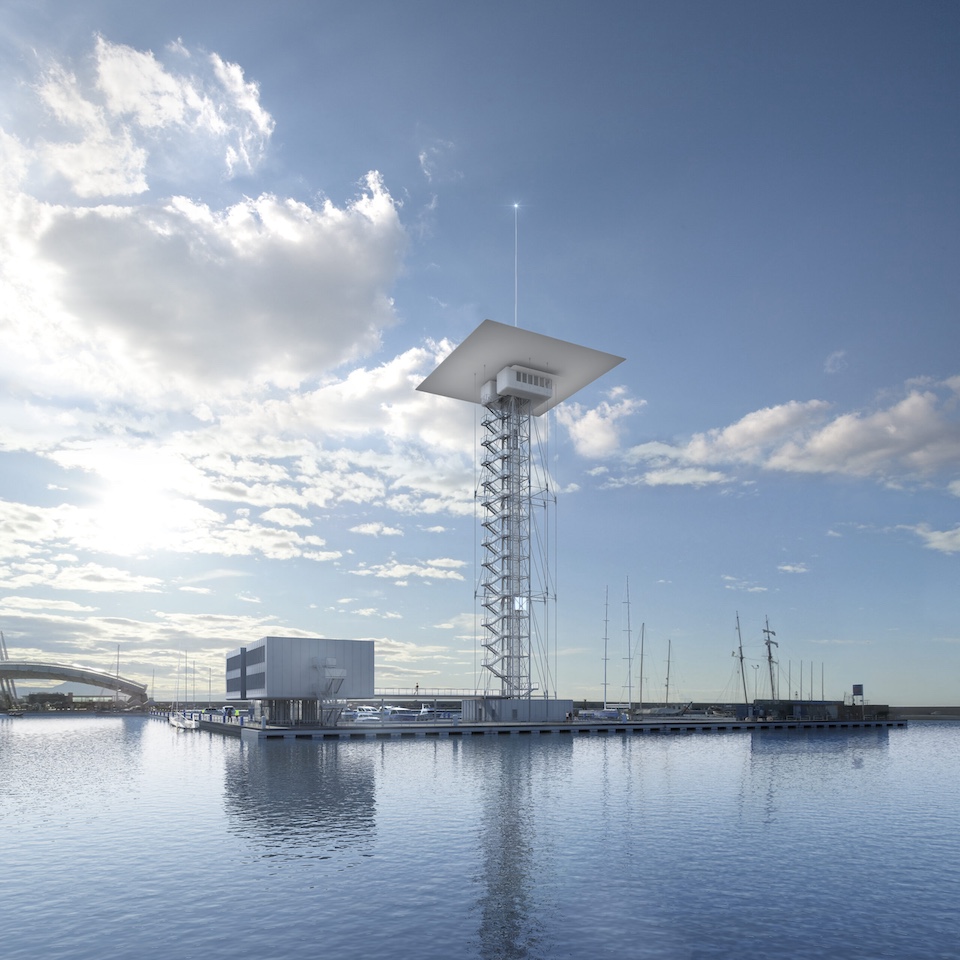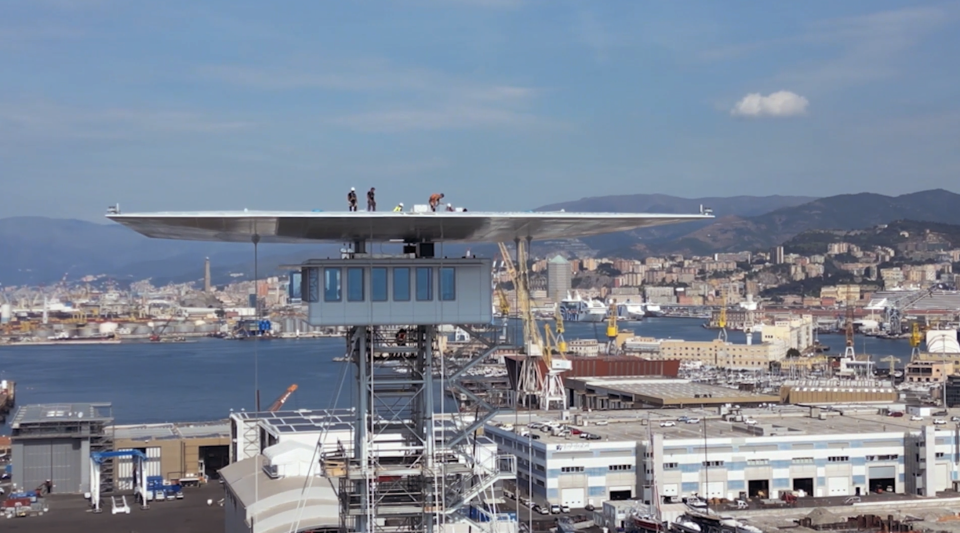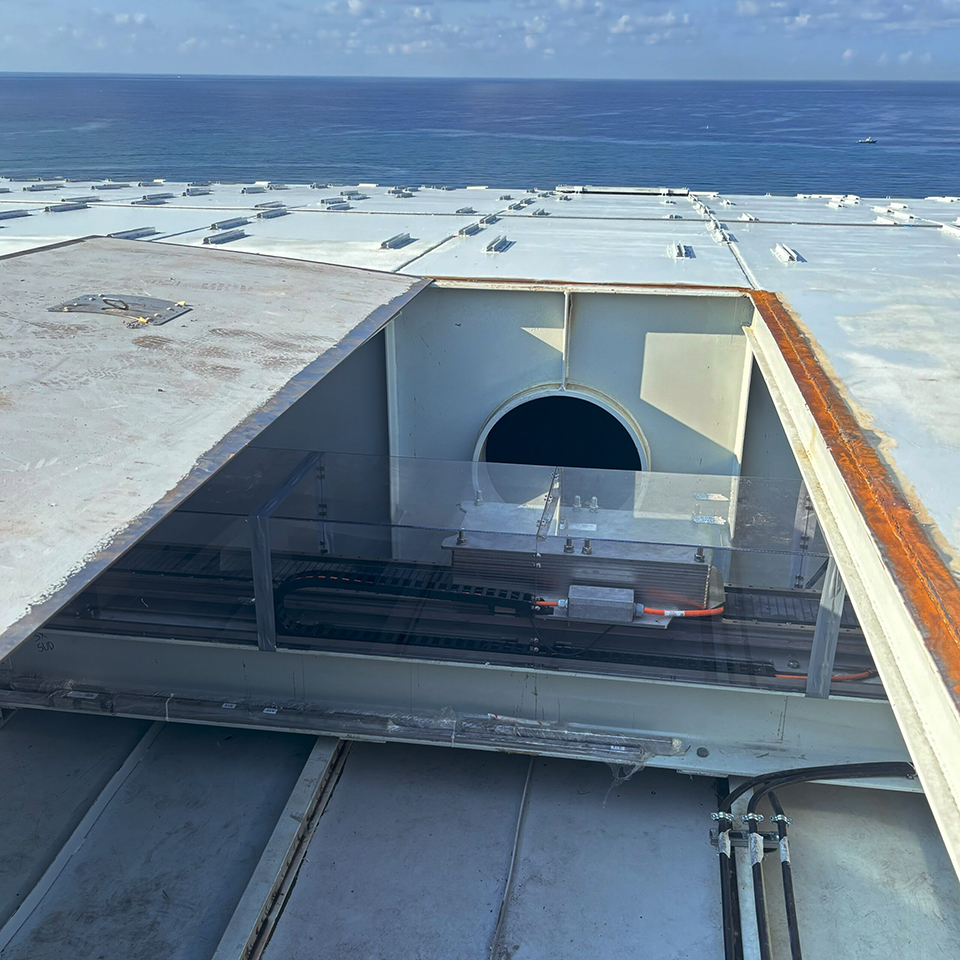Julia Davis
CEE’s Paolo Calvi implemented a cutting-edge technological solution to stabilize a new Italian control tower in the Port of Genoa, ensuring safety from high winds.
Watch how active mass damper technology, implemented with the expertise of CEE’s Paolo Calvi, stabilizes Genoa’s Torre Piloti against high winds. Video courtesy of ISAAC.

A view of the Torre Piloti in the Port of Genoa.
When wind threatened the stability of Genoa’s newly designed port control tower, CEE’s Paolo Calvi implemented active mass dampers — devices that stabilize structures by counteracting vibrations as they occur.
When high winds threaten the stability of structures, the challenge lies in preserving both form and function. Nowhere is this balance more evident than in the newly designed Torre Piloti, a control tower essential for managing maritime traffic at the bustling Port of Genoa in Italy. The new tower replaces the original structure that tragically collapsed in 2013 following a cargo ship collision, claiming nine lives.
The Torre Piloti, designed by renowned architect Renzo Piano, is 65 meters (213 feet) tall and is vital for managing maritime traffic at one of the Mediterranean’s busiest ports. Supported by four steel columns and cross braces, it rises above the waterfront as a modern landmark. A control room perched at its summit is used to monitor and manage maritime operations. However, extensive wind tunnel tests revealed that high winds would induce vibrations far beyond acceptable thresholds, jeopardizing the control room's safety and usability.
Associate Professor Paolo Calvi was tasked with addressing these excessive wind-induced vibrations in the tower. Faced with a strict timeline to complete the Torre Piloti by October 2024, in time for Genoa’s prestigious maritime festival, the project demanded a solution that could be implemented swiftly without altering the tower’s slender design. Calvi was brought in late in 2023 to assess the problem and propose a solution within these constraints.
“The structure was not at risk of collapsing,” Calvi explains, “but the vibrations posed a serious challenge for those that would be working in the control room. People could feel sick or even lose their balance.”
Calvi explored multiple solutions but found them impractical due to the tower’s unique design and spatial constraints. This led him to propose active mass dampers (AMDs), an advanced technology that actively counters vibrations by detecting motion and generating stabilizing forces almost instantly.
A high-tech solution for high winds
Unlike passive systems, which use a mass attached to the structure to reduce vibrations, active mass dampers (AMDs) detect and counteract motion within fractions of a second. Imagine a tightrope walker using a pole to maintain balance — AMDs work similarly, adjusting instantly to keep the tower steady when winds push it.
Four compact AMD units, each weighing 300 kilograms, about the weight of a grand piano, were installed at the tower’s roof level. Controlled by a central system and a network of sensors, these devices detect vibrations and instantly adjust, generating counterforces to stabilize the structure in less than a second.

Mechanical engineers work on the roof of the Torre Piloti to install the active mass dampers.
Calvi describes the AMDs as “dynamic stabilizers,” adding, “Active dampers are essentially real-time problem solvers. They generate inertial forces that counteract structural motion, keeping the tower steady even in strong winds.”
This solution enabled the design team to reduce vibrations while preserving the tower’s sleek profile. Though AMDs have been explored in research, their implementation in the Torre Piloti marks a milestone as one of the first times this technology has been applied to a real-world structure of such prominence and complexity.
Testing the limits of sway control

Close-up view of an active mass damper installed within the roof of the Torre Piloti, showing its compact design and rail system.
Calvi collaborated with ISAAC, a Milan-based company specializing in active vibration control systems, to bring the AMD solution to life. ISAAC’s expertise in mechanical engineering complemented Calvi’s structural dynamics approach, resulting in a solution that worked for the tower’s unique needs.
The team conducted advanced numerical modeling, lab tests and real-world simulations, where they simulated wind conditions to measure how the tower reacted to vibrations with and without the active mass dampers.
The results were striking: the AMDs reduced vibrations by up to 10 times, transforming the control room into a safe and comfortable workspace even during high winds.
“Seeing the system in action during the tests was extremely rewarding,” says Calvi. “It showed how engineering and technology can come together to solve real-world problems.”
Shaping the future of structural stability
The Torre Piloti’s AMD system demonstrates how advanced engineering techniques can address modern structural challenges. Active control systems could transform how engineers stabilize tall, slender structures and even older buildings needing retrofits. Their compact design allows for integration into existing buildings with minimal disruption, making them particularly appealing for modern engineering projects.
“You can essentially install it on the roof without affecting the structure during the process,” Calvi says.
Looking ahead, Calvi sees potential for expanding AMD applications to seismic retrofits and other challenging environments. He is already collaborating with ISAAC on a new project to test the technology in historic bell towers in Italy.
For Calvi, the Torre Piloti project represents a unique opportunity to blend engineering ingenuity with architectural artistry. Working on a notable structure in his home country was a personal and professional milestone.
“This was a special project for me,” he says. “It was exciting to work on something significant for Genoa, a tower that reflects both functionality and the creativity of science and architecture.”
Originally published January 15, 2025